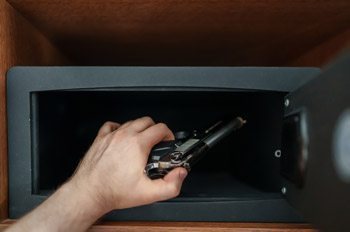Protecting Loved Ones with Safe Gun Storage
by Jenna Steichen
January 2025
Guns are a common presence in many North Dakota homes, valued for security, recreation, and cultural tradition. They may provide a sense of security in protecting one's home and family, aid in obtaining tasty venison sausage, and serve as a source of entertainment with various hunting and sporting events. However, gun owners also understand the responsibility of gun ownership comes with keeping these firearms out of the wrong hands.
In North Dakota just over 50% of households possess firearms, the ninth highest gun ownership rate in the U.S., according to the RAND corporation – and from a national survey, researchers also found that only about 45% of the country's gun owners properly store and secure all their firearms.
Proper storage consists of guns being stored unloaded and with some type of locking device. When thinking about a gun storage solution, there are multiple factors to consider including who lives in the home, their ages, risk for break-ins related to length of time away from home, and personal preference for quick access to the firearm if kept for protection. These factors considered, a storage solution can be tailored to meet individual needs and preferences. In all cases, it's best to store firearms unloaded and separate from ammunition. Additionally, coinciding combinations, codes, and keys should be stored in a separate location from the locking device itself.
 The first storage option
is the gun safe. Heavy and more expensive, they are
considered the most secure option as they can accommodate
multiple firearms, deter theft due to weight and size,
and keep guns out of sight. Another option is a lock box,
which may be more ideal for those wanting quick access to
firearms, such as those using guns for protection.
However, due to its smaller size, it's easy to steal
unless attached to a bigger object. A third option is
mechanical gun locks, like a trigger or a cable lock. A
trigger lock fits over the trigger and has a trigger
guard device, while a cable lock doesn't allow the
external loading of ammunition. While these options are
less expensive, they're not intended to be used as a sole
storage option as they can be cut or dismantled.
The first storage option
is the gun safe. Heavy and more expensive, they are
considered the most secure option as they can accommodate
multiple firearms, deter theft due to weight and size,
and keep guns out of sight. Another option is a lock box,
which may be more ideal for those wanting quick access to
firearms, such as those using guns for protection.
However, due to its smaller size, it's easy to steal
unless attached to a bigger object. A third option is
mechanical gun locks, like a trigger or a cable lock. A
trigger lock fits over the trigger and has a trigger
guard device, while a cable lock doesn't allow the
external loading of ammunition. While these options are
less expensive, they're not intended to be used as a sole
storage option as they can be cut or dismantled.
If gun owners have concerns about proper storage options and want advice about what might work best for their unique situation, local law enforcement, hunting organizations, and other experts – including active duty or military veterans – are resources for advice.
No gun owner wants their firearm to fall into the wrong hands like those of small children, impulsive teenagers, someone struggling with addiction or mental health challenges, or experiencing a particularly horrible day. Imagine these settings: a second grader proudly showing her friend the new rifle her dad got for deer season, unaware that the gun is loaded, and her finger is on the trigger as she lifts it; a 54-year-old man, recently laid off from the job he's had for 15 years, returns home, uncertain about how he'll pay the rent or buy groceries who begins thinking about his son's gun currently kept in the garage, or the setting where several friends are packing for their upcoming hunting trip, when one, having had a few too many beers, becomes careless when reenacting his big kill from their annual hunt last year.
It's human to have the mindset of "that would never happen to me." However, when little minds are curious, people are in despair or have mental health challenges, or decisions are impaired by drugs, or alcohol, firearms that are not safely stored can lead to unintentional firearm deaths. For these reasons, gun owners who safely secure their firearms know they are creating a safer environment for their families, their friends, and their communities.
About the Author
 Jenna Steichen is a third-year medical student at
the University of North Dakota School of Medicine &
Health Sciences. She was selected as the Jamestown
participant for the school's ROME program, or Rural
Opportunities in Medical Education. Part of the ROME
program teaches student doctors how rural newspapers can
be partners for disseminating health information. The
information presented here is not intended for diagnosis
or treatment and should not be used in place of previous
medical advice provided by a licensed provider.
Jenna Steichen is a third-year medical student at
the University of North Dakota School of Medicine &
Health Sciences. She was selected as the Jamestown
participant for the school's ROME program, or Rural
Opportunities in Medical Education. Part of the ROME
program teaches student doctors how rural newspapers can
be partners for disseminating health information. The
information presented here is not intended for diagnosis
or treatment and should not be used in place of previous
medical advice provided by a licensed provider.
